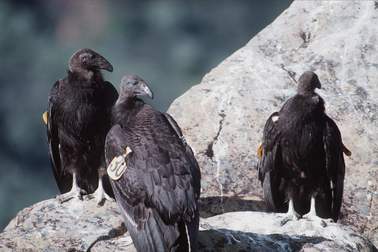Nov 6 2012
Moving animals for conservation is not a panacea. This is what Irene Pérez and colleagues from Arizona State University and several Spanish institutions have concluded after evaluating 280 published translocation projects worldwide and 107 unpublished Spanish projects.
 California condors are among the species that have been translocated by the U.S. Fish and Wildlife Service in an attempt to stabilize threatened populations. Photo by: U.S. Fish and Wildlife Service
California condors are among the species that have been translocated by the U.S. Fish and Wildlife Service in an attempt to stabilize threatened populations. Photo by: U.S. Fish and Wildlife Service
Translocation is the term used to refer to the movement of living organisms from one area to another in hopes of recovering a threatened species. One example is the translocation of the California condor into parts of the Sonoran Desert, just one of thousands of projects that are currently going on in the U.S. and worldwide.
The result of their study, published in the November issue of the journal Frontiers in Ecology and the Environment, is forthright: most translocations are unjustifiable from a conservation perspective or inadequately designed to guarantee success or preclude negative consequences.
Why are these problematic projects developed? The authors point to several reasons, such as aesthetic or sociopolitical motivations and the use of translocations as “simple solutions” to complex conservation problems.
Releasing individuals of a species is a relatively feasible and socially attractive strategy compared to the establishment of protected areas or the restriction of development projects. Pérez, a faculty research associate in the School of Human Evolution and Social Change in the College of Liberal Arts and Sciences, and her collaborators believe the reason why there are so many deficient translocation projects is because clear, objective guidelines for determining when certain translocations should be undertaken are still lacking.
To remedy this issue, the authors endorse a system for evaluating the suitability of proposed translocation projects. Using this system allows not only the evaluation of the necessity for a given project, but also the technical and logistical design, as well as associated risks of the project.
Pérez is passionate about her work. She studies how people view, understand and use nature and natural resources, and she looks for efficient management options. Her final goal is to contribute to biodiversity conservation and the sustainable use of natural resources.
“Humans have a huge responsibility in avoiding species extinctions because we are the cause of the threatened situation of many species worldwide,” she says. “But we don’t want to spend our time and money on useless projects while tackling this tremendous task of conserving wildlife.”
Pérez’s study offers a guide to help curb species extinctions by reducing the number of inappropriate translocation projects and enabling more efficient use of the scarce resources invested in conservation. The system is particularly useful to planners and wildlife managers, who face the difficult decision of whether a species should be translocated.